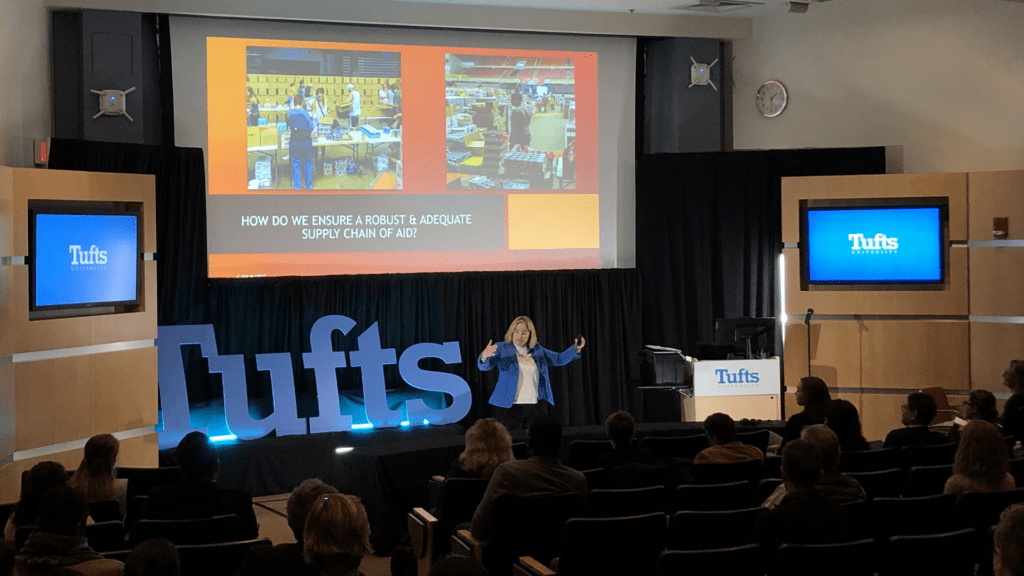
Our team works a lot of events. And we’d like to think we’ve learned a thing or two over the years! When we approach planning an event with a client, we share our experiences from similar events and explain why certain things might be important to include, or not include. There are some things that we see are consistently overlooked when planning for A/V at events, so we’ve compiled a list of some of the most common mistakes we’ve noticed so that you know what to prepare for.
Lighting your stage is a critically important component of any event. But it’s not just about the pretty creative uplighting on your backdrop. Your subject on stage needs to be lit too, and believe it or not, that’s something that we frequently see is overlooked at events. If your subject on stage is not lit, they are going to look dark and blend into the background. Especially if you’re trying to record or live stream the session. We like to call this being “stuck in the mud”. Uplighting on your backdrop is also important, because it will help separate your subject from the backdrop and give your stage a little more of an elevated feel. That said, it is all about finding a balance. If the lights on the subject or speakers are too bright, it could be distracting for them and be an unpleasant experience. But they do still need to be lit and seen! So, it’s all about finding the right balance between not blinding the speaking while also not having them be “stuck in the mud”.

In an effort to keep costs down, sometimes the staffing is what takes a hit. Or maybe as an event organizer, you’ve made sure to include all the right equipment, but haven’t thought about who is going to run it, or don’t realize the benefit of some extra hands on site! Common roles that can slip through the cracks can be stage managers, mic runners for Q&A, audio technicians, or stage hands. Sometimes, it can be hard to know that these roles are important until you’ve gone through an event without them. Luckily, we’ve been through an event or two and our team has seen how events run with and without these people (spoiler alert: events always run smoother when these roles are filled). Clearly defining your A/V and event teams’ roles prior to the event will help ensure that you have enough staff to cover each aspect of your event and make sure it runs smoothly.
The stage and the audience seating are the easy first steps when you’re thinking about the physical space at your event. But where is the A/V team going to be set up? Is there a back of house? Where will the speakers wait before they go on stage? Is there a green room area? These are separate spaces that you should also allocate space for when mapping out your floor plans during setup.
Another aspect of the physical set up that is sometimes missed are things like internet or extra power in your event space. These things are “just there” in many situations, and it can cost a lot of money if you are not prepared.
There are lots of other miscellaneous parts of the physical space you need to think about. For example, the camera setup. The cameras need to be just as high as the stage so that you aren’t getting shots of the back of the audience’s heads. Does that mean you need risers? Tripods that can go up higher? Another example is outdoor vs indoor events. If your event is outside in a tent during the day, things like projection screens just won’t work. There are lots of little details that can be missed that might be super specific to your event depending on the circumstances (and that’s when it’s helpful to work with companies like us who have seen a thing or two when it comes to events)!
There is a lot of preparation that happens prior to an event. But you need to make sure that this includes prepping speakers as well! When the event organizers, A/V team, and speakers are all on the same page, everything is going to run more efficiently. Communicating things like whether or not the speakers need to be able to see their notes during their presentation, or if they need to be able to share their screen, or play a video, are all important topics to cover. It’s also important to make sure that speakers know when they need to have their presentations submitted for the event. It’s not always a bad thing to be flexible but last minute changes can get you into trouble. This can create confusion and a rush to get things done and organized too quickly before the speaker has to go up on stage. If the speakers are prepped with all of this information before arriving on site, it creates more clear expectations.
This is by no means an extensive list of things we’ve seen be forgotten about at events, but they are some of the most common things our team has experienced first hand!
For more about what you should be looking out for when planning A/V for an event, watch our webinar about picking an A/V company, or listen to our podcast episodes about working with an A/V partner and when you might need an “A/V translator”. Want to chat about how to sort some of these things out for your next event? Let’s get in touch!